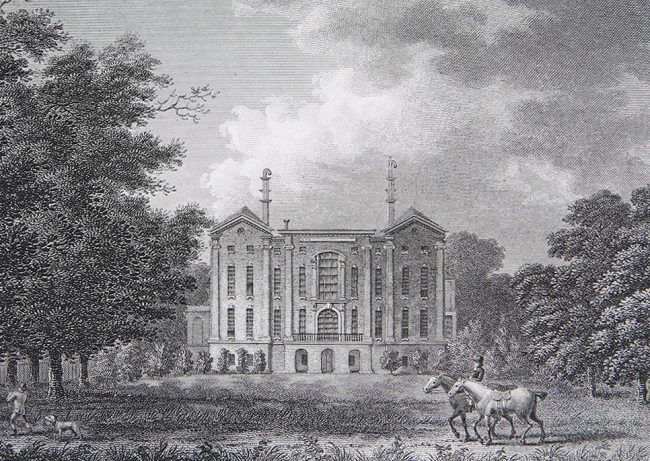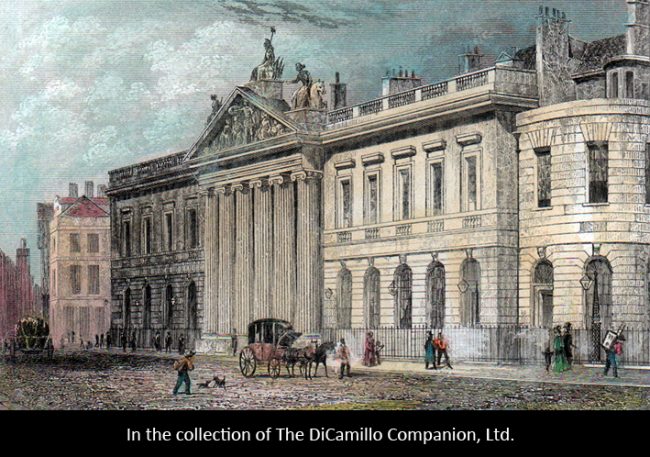
An 1810 engraving of the house from "Angus's Views of Seats." By kind permission of a private collection.

East India House, headquarters of the East India Company, London, from an 1842 hand-colored engraving.
Built / Designed For: William Draper
House & Family History: Officially, Addiscombe's architect is unknown; Hawksmoor is often credited with the design because William Draper was the treasurer to the Commissioners for Greenwich Hospital at the same time that Hawksmoor was clerk of the works at the hospital. Draper's father-in-law was the diarist John Evelyn, who, after a visit to Addiscombe in 1703, pronounced the house "in all points of good and solid architecture to be one of the very best gentleman's houses in Surrey, when finish'd." The interior was noted for its many murals of mythological subjects supposedly painted by Sir James Thornhill. During the time that Addiscombe was the seat of the 1st Lord Liverpool, George III and William Pitt were regular visitors. After the death of Lord Liverpool in December 1808, Addiscombe Place was sold to the Court of Directors of the East India Company for use as a military academy: Addiscombe Military Seminary. Formally called The East India Company Military Seminary, it was established to train officers for the company's Indian army. The Indian Rebellion (First War of Independence) of 1857 changed everything. The British Parliament dissolved the East India Company in 1858 and took over direct rule of India itself. The seminary came into the ownership of the government and was renamed the Royal Indian Military College, Addiscombe. Ultimately, however, with the merger of the Royal and Indian services in 1861, the Royal Indian Military College was deemed redundant and it was closed in June of 1861 (after making an evaluation of its needs, the War Office decided that the military schools at Woolwich and Sandhurst were sufficient for their requirements for Indian officers.) The site was sold in August 1861 for £33,600 to the British Land Company, who demolished the house and redeveloped the site with villas.
Architect: Edward Strong Jr.
Date: 1702-03Architect: Nicholas Hawksmoor
Date: 1702-03Architect: William Wilkins Jr.
Date: 1825-28
Title: Biographical Dictionary of British Architects, 1600-1840, A - HARDBACK
Author: Colvin, Howard
Year Published: 2008
Reference: pgs. 499, 997, 1124
Publisher: New Haven: Yale University Press
ISBN: 9780300125085
Book Type: Hardback
House Listed: Demolished
Park Listed: Destroyed
Past Seat / Home of: William Draper, early 18th century. Charles James Clarke, late 18th century. Charles Jenkinson, Lord Hawkesbury, later 1st Earl of Liverpool, until 1808.
Current Ownership Type: Demolished
Primary Current Ownership Use: Demolished
House Open to Public: No
Historic Houses Member: No